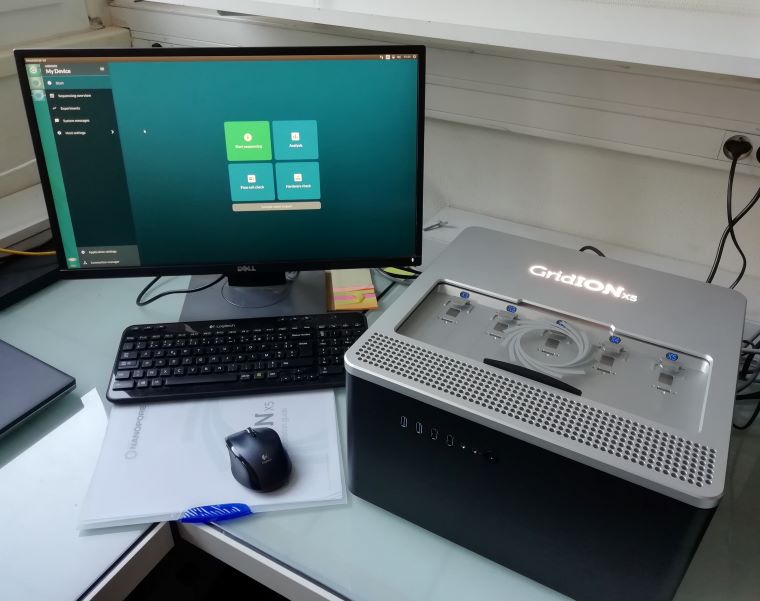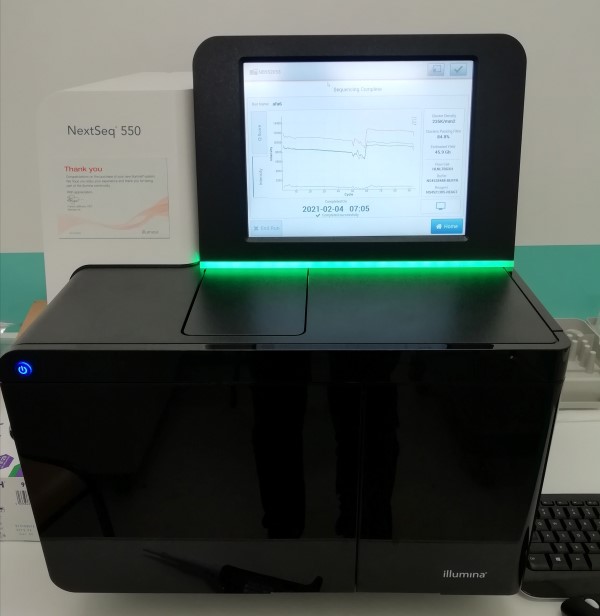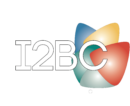Next Generation Sequencing
Equipments


- 2 Oxford Nanopore Technologies sequencers: GridION and PromethION 2 Solo;
- 2 Illumina sequencers: NextSeq 550 and NextSeq 2000;
- Chromium controller – 10X Genomics;
- Covaris sonicator, Bioanalyzer, Qubit;
- Computer resources:3 workstations including one with GPUHigh performance computing cluster (I2BC infrastructure)
Backup servers located in separate buildings (I2BC infrastructure)
Rates
- our facility now offers sequencing on the Oxford Nanopore Technologies GridION sequencer, as part of collaborative projects.
For more information, please contact us: sequencage-i2bc@i2bc.paris-saclay.fr - our prices are currently under revision, for more information, please contact us at : sequencage-i2bc@i2bc.paris-saclay.fr
Request Form
Services
The NGS Core Facility offers:
Illumina library preparation
- DNA-seq, ChIP-seq
- RNA-seq
- Small RNA-seq, miRNA-seq
- Single Cell sequencing (10X Genomics)
- Custom-made libraries if needed
Nanopore library preparation (collaborative projects)
- DNA-seq
- RNA-seq (direct RNA)
- RNA-seq (cDNA)
- Custom-made libraries if needed
Sequencing:
- Oxford Nanopore Technologies sequencers: GridION and PromethION 2 Solo
- Illumina NextSeq sequencers
Bioinformatics:
- Genome assembly:
=> Illumina
=> Oxford Nanopore Technologies (ONT)
=> Illumina + ONT (hybride) - SNP, indels, chromosome rearrangements detection
- Differential gene expression analysis
- Modified bases detection by direct ONT sequencing (under development)
- Personalized analysis according to user needs
Guidelines for sample preparation
Please read carefully these guidelines before preparing your material for sequencing
Samples must be in 1.5mL or 2mL tubes.
Write distinctly the sample codes received with your quote on the lid of your tubes.
Please do not use stickers.
Feel free to add any useful information on the side of the tube.
We exclusively rely on the Qubit fluorometric quantitation system (Thermo Fisher) for any nucleic acid quantification. We will perform a Qubit quantification of your samples shortly after reception. Note that spectrometric methods (such as Nanodrop) often provide an overestimation of the concentration and are very sensitive to contaminants (chemicals or other nucleic acids).
If your material does not follow the described criteria, please contact us before sending your samples.
Illumina Genomic DNA libraries:
Most kits provided by biotech companies usually work for sequencing purpose.
Please provide us 100-2000 ng of genomic DNA. The concentration should be at least 10 ng/ μL (measured with Qubit), in Tris 10mM buffer (pH 7.5 – 8) or H2O.
Do not use TE buffer or any buffer containing EDTA, as it can inhibit some enzymatic reactions.
DNA should be in a clear solution without any precipitate at room temperature.
DNA should be checked by running an aliquot on agarose gel. There should be no significant degradation or small size material visible on the gel.
ONT Genomic DNA libraries:
We highly recommend a phenol chloroform extraction but you also can use high molecular DNA extraction kits from biotech companies.
Please provide us with 3 µg of genomic DNA. The concentration should be at least of 20 ng/ µL (measured with Qubit), in Tris 10mM buffer (pH 7.5 – 8) or H2O.
Please contact us if you can’t respect those conditions.
Do not use TE buffer or any buffer containing EDTA, as it can inhibit some enzymatic reactions.
DNA must be in a clear solution without any precipitate.
DNA should be checked by running an aliquot on agarose gel.
If you have a Field Inversion Gel Electrophoresis System, or any system who permit checking the high molecular weight of samples, please provide us the results.
There should be no significant degradation or small size material visible on the gel.
ChIP-Seq libraries :
> 2 ng of 100-400bp dsDNA. If your fragments are not in this size range please ask us for a protocol modification. Libraries made from <5 ng DNA might not be of optimal quality, especially if outside of the optimal size range.
Libraries with lower amount of DNA can be constructed, however we cannot guarantee their quality in such conditions.
RNA-seq libraries :
Most commercially available RNA extraction kits are compatible with downstream NGS analyses ; it is often mentioned in the documentation if a kit is compatible with RNA-seq analysis. All RNAs have to be in nuclease-free H2O.
RNA-seq library preparation is very sensitive to genomic DNA contamination especially when the samples are treated for rRNA depletion (Ribo-Zero). This is less critical for libraries with polyA selection. Please make sure that your extraction protocol comprise a DNAse treatment. It is better to perform an additional DNAse treatment if your samples are ongoing rRNA depletion. We have no means to detect DNA contamination in the samples.
RNA quality will be assessed by Bioanalyzer RNA 6000 pico chip (Agilent technologies). Total RNA is considered high quality when the RIN (RNA Integrity Number) is >8. If you performed such analysis, the results can be helpful to us. We will be happy to give you our opinion about it prior to sample submission.
For polyA selection based libraries, RIN should be >8. A 7<RIN<8 might be considered acceptable if your material is difficult to obtain but be aware that the representation of mRNA species might be biased. We do not recommend to start from RIN<7 total RNA.
For rRNA depletion (Ribo-Zero) any RNA can be processed. Degradation may however lead to a less efficient rRNA depletion, resulting in more rRNA reads and thus the need of deeper sequencing than libraries from high quality samples.
Most library preparation kits allow to work with a broad quantity range (ex : 250-1000ng). Under these input quantities recommendations we can not guarantee the quality of the library preparation (it may lead to biased representation of RNA species or high rate of PCR duplicates). Being in the higher range allows to maximize the chance to have higher quality libraries.
RNA-seq with polyA selection (Truseq Illumina Stranded protocol) : 250 ng – 5µg of high quality total RNA (RIN>8).
Maximum volume = 30µL
RNA-seq with Ribo-Zero depletion (procaryotes/eucaryotes : Illumina Ribo-Zero + Truseq Illumina Stranded protocol) :
200ng – 5µg of total RNA. Maximum volume = 30µL
RNA-seq from rRNA depleted RNA or polyA enriched mRNA (Illumina Truseq Illumina Stranded protocol) : 5 ng- 100 ng of mRNA. Maximum volume = 20µL
Small RNA libraries :
All RNAs have to be in nuclease-free H2O.
1-5µg of total RNA or 50-100 ng purified small RNA. Volume max. = 15 µL in water.
Degraded RNA may lead to lower quality libraries.
Other type of libraries :
please contact us I2BC-sequencage@i2bc.paris-saclay.fr
Acknowledgements
The technical contribution of the platform must be recognized and clearly mentioned in publications or reports as follows : « We acknowledge the sequencing and bioinformatics expertise of the I2BC High-throughput sequencing facility, supported by France Génomique (funded by the French National Program “Investissement d’Avenir” ANR-10-INBS-09). ». A copy of the paper/publication should be sent (PDF) to the platform (sequencage-i2bc@i2bc.paris-saclay.fr).
Contact us / Where to find us!
Please ship your samples to this address:
Plateforme de Séquençage Haut Débit I2BC – UMR9198
c/o Magasin de l’I2BC
CNRS, Bât. 23A
Avenue de la Terrasse
91198 Gif-sur-Yvette
France
Mailing address/ where to deposit your samples:
Plateforme de Séquençage Haut Débit
I2BC- UMR9198
CNRS, Bât. 21 (N1, rooms 119-127)
Avenue de la Terrasse
91198 Gif-sur-Yvette
France
Email : sequencage-i2bc@i2bc.paris-saclay.fr
Tél : 01 69 82 31 90
